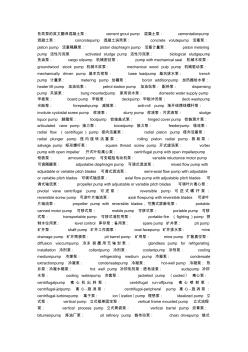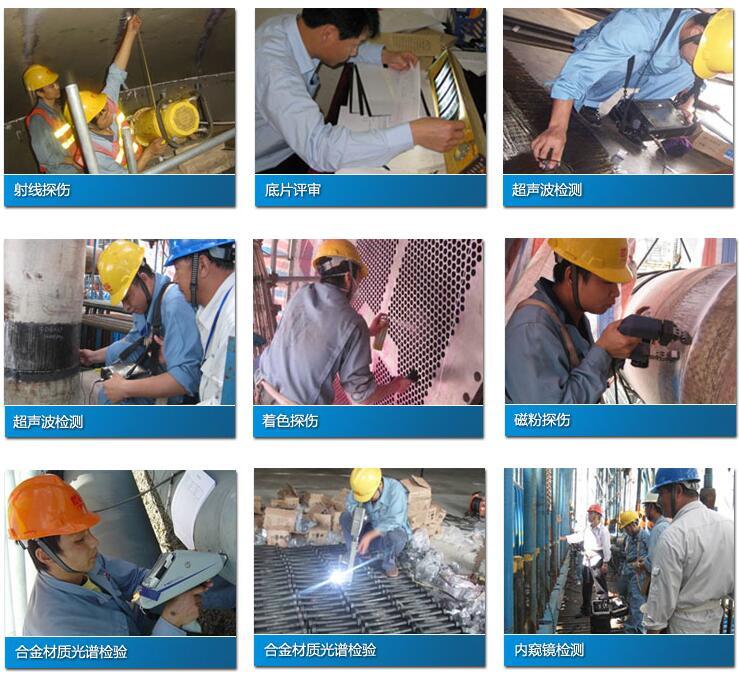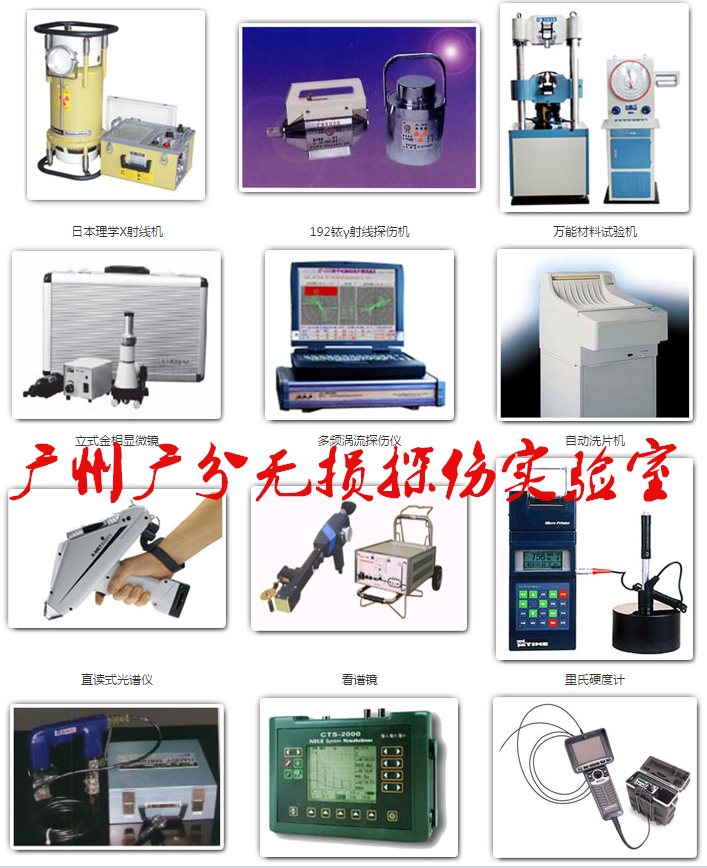ndt英文翻译
What's NDT
The field of Nondestructive Testing (NDT) is a very broad, interdisciplinary field that plays a critical role in assuring that structural components and systems perform their function in a reliable and cost effective fashion. NDT technicians and engineers define and implement tests that locate and characterize material conditions and flaws that might otherwise cause planes to crash, reactors to fail, trains to derail, pipelines to burst, and a variety of less visible, but equally troubling events. These tests are performed in a manner that does not affect the future usefulness of the object or material. In other words, NDT allows parts and material to be inspected and measured without damaging them. Because it allows inspection without interfering with a product's final use, NDT provides an excellent balance between quality control and cost-effectiveness. Generally speaking, NDT applies to industrial inspections. Technology that is used in NDT is similar to those used in the medical industry; yet, typically nonliving objects are the subjects of the inspections.
What is NDE"para" label-module="para">
Nondestructive evaluation (NDE) is a term that is often used interchangeably with NDT. However, technically, NDE is used to describe measurements that are more quantitative in nature. For example, an NDE method would not only locate a defect, but it would also be used to measure something about that defect such as its size, shape, and orientation. NDE may be used to determine material properties, such as fracture toughness, formability, and other physical characteristics.
Some NDT/NDE Technologies:
Many people are already familiar with some of the technologies that are used in NDT and NDE from their uses in the medical industry. Most people have also had an X-ray taken and many mothers have had ultrasound used by doctors to give their baby a checkup while still in the womb. X-rays and ultrasound are only a few of the technologies used in the field of NDT/NDE. The number of inspection methods seems to grow daily, but a quick summary of the most commonly used methods is provided below.
Visual and Optical Testing (VT)
The most basic NDT method is visual examination. Visual examiners follow procedures that range from simply looking at a part to see if surface imperfections are visible, to using computer controlled camera systems to automatically recognize and measure features of a component.
Radiography (RT)
RT involves the use of penetrating gamma- or X-radiation to examine material's and product's defects and internal features. An X-ray machine or radioactive isotope is used as a source of radiation. Radiation is directed through a part and onto film or other media. The resulting shadowgraph shows the internal features and soundness of the part. Material thickness and density changes are indicated as lighter or darker areas on the film. The darker areas in the radiograph below represent internal voids in the component.
Magnetic Particle Testing (MT)
This NDT method is accomplished by inducing a magnetic field in a ferromagnetic material and then dusting the surface with iron particles (either dry or suspended in liquid). Surface and near-surface flaws produce magnetic poles or distort the magnetic field in such a way that the iron particles are attracted and concentrated. This produces a visible indication of defect on the surface of the material. The images below demonstrate a component before and after inspection using dry magnetic particles.
Ultrasonic Testing (UT)
In ultrasonic testing, high-frequency sound waves are transmitted into a material to detect imperfections or to locate changes in material properties. The most commonly used ultrasonic testing technique is pulse echo, whereby sound is introduced into a test object and reflections (echoes) from internal imperfections or the part's geometrical surfaces are returned to a receiver . Below is an example of shear wave weld inspection. Notice the indication extending to the upper limits of the screen. This indication is produced by sound reflected from a defect within the weld.
Penetrant Testing (PT)
The test object is coated with a solution that contains a visible or fluorescent dye. Excess solution is then removed from the surface of the object but leaving it in surface breaking defects. A developer is then applied to draw the penetrant out of the defects. With fluorescent dyes, ultraviolet light is used to make the bleedout fluoresce brightly, thus allowing imperfections to be readily seen . With visible dyes, vivid color contrasts between the penetrant and developer make "bleedout" easy to see. The red indications below represent a number of defects in this component.
Electromagnetic Testing (ET)
Electrical currents (eddy currents) are generated in a conductive material by a changing magnetic field. The strength of these eddy currents can be measured. Material defects cause interruptions in the flow of the eddy currents which alert the inspector to the presence of a defect. Eddy currents are also affected by the electrical conductivity and magnetic permeability of a material, which makes it possible to sort some materials based on these properties. The technician below is inspecting an aircraft wing for defects.
Leak Testing (LT)
Several techniques are used to detect and locate leaks in pressure containment parts, pressure vessels, and structures. Leaks can be detected by using electronic listening devices, pressure gauge measurements, liquid and gas penetrant techniques, and/or a simple soap-bubble test.
Acoustic Emission Testing (AE)
When a solid material is stressed, imperfections within the material emit short bursts of acoustic energy called "emissions." As in ultrasonic testing, acoustic emissions can be detected by special receivers. Emission sources can be evaluated through the study of their intensity and arrival time to collect information about the sources of the energy, such as their location.
-
ndt造价信息
因此,作为标准化的术语,推荐使用“无损检测”一词,对应的英文词则推荐使用“Non-destructive testing”。各种无损检测方法的名称,也同样推荐使用“检测”一词,如射线照相检测、超声检测、磁粉检测、渗透检测、涡流检测等等。在翻译时,与 Non-destructive 相连用的如 inspection、examination、evaluation 等英文词,都推荐译成“无损检测”一词,尽量避免写作“无损探伤”、“无损检查”、“无损检验”、“无损评价”等。这一译法也同样适用于各种无损检测方法名称的译法。
注:inspection、examination、evaluation 等词,仅在翻译无损检测及其方法的名称时才推荐译成“检测”一词,其他场合宜依据原文内容和中文习惯来翻译。
NDT 能应用于产品设计、材料选择、加工制造、成品检验、在役检查(维修保养)等多方面,在质量控制与降低成本之间能起最优化作用。NDT还有助于保证产品的安全运行和(或)有效使用。NDT 包含了许多种已可有效应用的方法,最常用的 NDT方法是:射线照相检测、超声检测、涡流检测、磁粉检测、渗透检测、目视检测、泄漏检测、声发射检测、射线透视检测等。
由于各种 NDT 方法,都各有其适用范围和局限性,因此新的 NDT 方法一直在不断地被开发和应用。通常,只要符合 NDT 的基本定义,任何一种物理的、化学的或其他可能的技术手段,都可能被开发成一种 NDT 方法。
在我国,无损检测一词最早被称之为探伤或无损探伤,其不同的方法也同样被称之为探伤,如射线探伤、超声波探伤、磁粉探伤、渗透探伤等等。这一称法或写法广为流传,并一直沿用至今,其使用率并不亚于无损检测一词。
在国外,无损检测一词相对应的英文词,除了该词的前半部分——即 Non-destructive 的写法大多相同外,其后半部分的写法就各异了。如日本习惯写作 inspection,欧洲不少国家过去曾写作 flaw detection、现在则统一使用 testing,美国除了也使用 testing 外,似乎更喜欢写作 examination 和 evaluation。这些词与前半部分结合后,形成的缩略语则分别是 NDI、NDT 和 NDE,翻译成中文就出现了无损探伤、无损检查(非破坏检查)、无损检验、无损检测、无损评价等不同术语形式和写法。实际上,这些不同的英文及其相应的中文术语,它们具有的意义相同,都是同义词。为此,国际标准化组织无损检测技术委员会(ISO/TC 135)制定并发布了一项新的国际标准(ISO/TS 18173:2005),旨在将这些不同形式和写法的术语统一起来,明确它们是有一个相同定义的术语、都是同义词,即都等同于无损检测(Non-destructive testing)。而不同的写法,仅仅是由于语言习惯不同而已。
ndt英文翻译常见问题
-
文摘 广义雅可比06加上对称quasi-minimal对角预处理SQMR残余()方法 已经证明是有效解决2·2块线性方程组引起离散 Biots固结方程。然而,有一种可能会进一步提高其性能采用更加复杂了...
-
1.Digtal Ammeter Adjustable, Aux input, 230V 1.可调数字电流表,辅助输入,230V 2. Digtal Kw Meter Adjustable, Aux ...
-
楼上 你不确定就不要回答呀 要是人家 用了你的 不正确 怎么办呢? 主创建筑师General Architect 参考 主任建筑师Architecture Conceptual Designer-柏景...
无损检测技术是第二次世界大战后在国际上迅速发展起来的一门新兴的综合性工程科学。无损检测技术又称非破坏检查技术(N0n-Destructive Testing),顾名思义,就是以不使被检查物使用性能及形态受到损伤为前提,通过一定的检测手段来检测或测量、显示和评估物质中因有缺陷或组织结构上的差异存在而会使其某些物理性质的物理量发生变化的现象,从而了解和评价材料、产品、设备构件直至生物等的性质、状态或内部结构等等的一种特殊的检测技术。在国际上,已经得到普遍认同:一个国家、一个地区、一个行业,直至一个企业的工业技术水平可以通过其无损检测的技术水平来反映。
是非破坏性试验的英文(Non-destructive testing)缩写,是指对材料或工件实施一种不损害或不影响其未来使用性能或用途的检测手段。通过使用 NDT,能发现材料或工件内部和表面所存在的缺欠,能测量工件的几何特征和尺寸,能测定材料或工件的内部组成、结构、物理性能和状态等。
按物理原理或检测对象和目的的不同,无损检测大致分为如下几种方法:
a) 渗透检测(penetrant testing,PT);
b) 磁粉检测(magnetic testing,MT);
c) 目视检测(visual testing,VT);
d) 超声检测(ultrasonic testing,UT);
e) 涡流检测(eddy current testing,ET);
f) 射线照相检测(radiographic testing,RT);
g) 泄漏检测(leak testing,LT);
h) 红外成像检测(infrared thermographic testing,TT或IT);
i) 声发射检测(acoustic emission testing,AT或AE) 。2100433B
ndt英文翻译文献

 北京工程标书翻译英文翻译
北京工程标书翻译英文翻译
精品文档就在这里 ------------- 各类专业好文档,值得你下载,教育,管理,论文,制度,方案手册,应有尽有 -------------- ------------------------------------------------------------------------------------------------------------------------------------------ -- --------------------------------------------------------- 精 品 文 档 --------------------------------------------------------------------- 标题 英文说明书翻译 手--机 :【131--1089 —3071 】 内容 简介 精诚翻

 各类泵的英文翻译
各类泵的英文翻译
各类泵的英文翻译混凝土泵: cement grout pump 混凝土泵: cementationpump 混凝土泵: concretepump 混凝土涡壳泵: concrete volutepump 活塞泵: piston pump 活塞隔膜泵: piston diaphragm pump 活塞计量泵: piston metering pump 活性污泥泵 activated sludge pump 活性污泥泵: biological sludgepump 货油泵: cargo oilpump 机械密封泵: pump with mechanical seal 机械木浆泵: groundwood stock pump 机械木浆泵: mechanical wood pulp pump 机械驱动泵: mechanically driven pump 基本负荷泵: base loadpum
无损检测简称NDT (Non-destructive testing)是工业发展必不可少的有效工具,在一定程度上反映了一个国家的工业发展水平,其重要性已得到公认。无损检测NDT (Non-destructive testing),就是利用声、光、磁和电等特性,在不损害或不影响被检对象使用性能的前提下,检测被检对象中是否存在缺陷或不均匀性,给出缺陷的大小、位置、性质和数量等信息,进而判定被检对象所处技术状态(如合格与否、剩余寿命等)的所有技术手段的总称。
颜经理:13926197149
无损检测的方法有:
超声检测 Ultrasonic Testing(缩写 UT);
射线检测 Radiographic Testing(缩写 RT);
磁粉检测 Magnetic particle Testing(缩写 MT);
渗透检验 Penetrant Testing (缩写 PT);


无损检测(NDT,Non-destructive testing)等。
AGFA 工业胶片 AGFA NDT D4 Film (D4 s.c. Film - D4单面涂层胶片)
AGFA NDT D5 Film
AGFA NDT D7 Film(国内分切片C7)
KODAK 工业胶片 主要有AA400产品 及国内分切片(了凯LA400型工业胶片)
其他数字化产品
富士工业胶片 原装自主品牌工业胶片及国内分切片(巨星贸易(上海)有限公司YESSTAR牌工业胶片)
德国NDTQUAM 工业胶片 M7系列
- 相关百科
- 相关知识
- 相关专栏
- ne555
- NEC CA4120X
- NEC CU4200XD
- NEC LCD3000
- NEC LCD4615
- NEC LCDP701
- NEC MultiSync PA271W
- NEC NEAX2400 IPX
- NEC NP-CR3117X
- NEC NP-P605UL+
- NEC PA241W
- NEC V421
- NEC VE2401XS
- NEC液晶显示器
- NEPCON China
- NESO 移动硬盘(120GB)
- 内蒙古沙麦岩体Ndt值的过铝质花岗岩
- 工程量清单计价模式下招投标阶段的工程造价控制英文翻译
- 施工中HSE健康、安全、环境管理的中英文翻译范文
- GBT30240-公共服务英文翻译标准规范
- 单片机基础电气工程及其自动化毕业论文中英文翻译
- 电子信息在工程造价管理中的应用中英文翻译
- 室内设计中英文翻译
- 上海城市交通隧道盾构施工技术综述英文翻译
- 建筑工程施工安全管理计划(中英文翻译)
- 中英文翻译机械设计
- EN欧盟无损检测NDT标准目录清单
- 土木建筑工程常用术语英文翻译及名词解释
- 工程项目管理中的造价管理中英文翻译
- 土木工程毕业论文中英文翻译
- 压缩机风机泵安装技术要求-英文翻译
- 市政道路施工协调管理现状中英文翻译